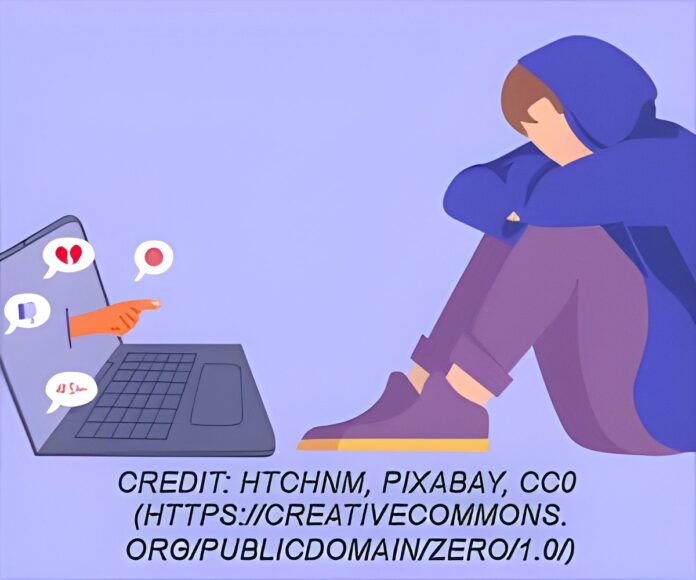Cyberbullying in all its forms is strongly linked to trauma symptoms in teens, often regardless of its visibility or perceived severity.
Cyberbullying should be recognized as an adverse childhood experience (ACE), a form of trauma known to cause lasting emotional, psychological, and physical harm, according to new national findings on adolescent mental health (1✔ ✔Trusted Source
Cyberbullying through the lens of trauma: an empirical examination of US youth
Go to source
).
While many assume that only extreme forms of online harassment – like threats or identity-based attacks – can cause significant harm, the findings suggest a more troubling reality: even less visible or indirect forms of cyberbullying can have equally damaging effects.
With more than 30% of students facing bullying globally, this is particularly alarming in the digital age, where cyberbullying is widespread and exacerbated by factors such as social media and online interactions.
Link Between Online Harassment and Trauma
The study, conducted by Florida Atlantic University in collaboration with the University of Wisconsin-Eau Claire, investigated the link between cyberbullying and trauma in a nationally-representative sample of 2,697 middle and high school students (ages 13 to 17) in the United States.
Researchers investigated the relationship between the prevalence of 18 different types of cyberbullying, including exclusion (being left out of an online group chat); impersonation (e.g., creating fake social media accounts in someone else’s name); and stalking behaviors (e.g., being tracked or monitored after the victim told the aggressor to stop) – and symptoms of PTSD.
Demographics and Emotional Vulnerability
The study also explored how demographic factors like age, sex and socioeconomic status influence the severity of psychological outcomes, identifying which groups of youth may be especially vulnerable.
Results, published in the latest issue of BMC Public Health, reveal that cyberbullying is both widespread and strongly linked to a validated nine-item Post Traumatic Stress clinical scale. What was especially striking was that exclusion and rejection, often dismissed as less serious, were just as trauma-inducing as explicit threats to one’s physical safety. Likewise, being the subject of gossip or cruel online comments had an emotional toll comparable to being harassed for personal traits like one’s race or religion.
All Forms of Cyberbullying Carry Trauma Risk
“As our research clearly shows, cyberbullying in any form – whether it’s exclusion from a group chat or direct threats – can lead to significant trauma in youth,” said Sameer Hinduja, Ph.D., lead author, a professor in the School of Criminology and Criminal Justice within FAU’s College of Social Work and Criminal Justice, co-director of the Cyberbullying Research Center, and a faculty associate at the Berkman Klein Center at Harvard University. “We were surprised to find that no single type of cyberbullying caused more harm than others; all carried a similar risk of traumatic outcomes. This means we can’t afford to dismiss or trivialize certain behaviors as ‘less serious’ – being left out or targeted by rumors can be just as detrimental as more overt attacks.”
Findings challenge common assumptions that only the most extreme cases of cyberbullying lead to psychological damage and spotlight the importance of understanding the unique lived experiences of each target. In reality, the emotional impact of online mistreatment – regardless of the form it takes – can deeply affect a young person’s sense of safety, identity and well-being depending on personal factors, situational context, and the strength of support from adults, institutions and peers.
High Prevalence of Indirect Cyberbullying
Among the different forms of online harassment, indirect forms were the most common. More than half of the surveyed students reported being the target of mean or hurtful comments or rumors, and a similar number said they were deliberately excluded from group chats or texts. Notably, almost 9 in 10 (87%) experienced at least one of the 18 forms of victimization, underscoring the increasing ubiquity of digital aggression and its normative presence when youth interact online.
When the researchers analyzed how cyberbullying relates to trauma, they found that girls and younger teens were more likely to experience higher levels of traumatic symptoms than boys or older teens. However, once they factored in how much cyberbullying each student had experienced, these demographic differences became less important.
Frequency of Cyberbullying as a Trauma Driver
“What mattered most was the overall amount of cyberbullying: the more often a student was targeted, the more trauma symptoms they showed,” said Hinduja. “In fact, cyberbullying alone accounted for a significant portion – 32% – of the differences in trauma levels among students.”
The study findings highlight the need for further research on protective factors, such as strong family support, close friendships and emotional resilience, which may buffer against the negative effects of interpersonal victimization in online spaces. The researchers also highlight the importance of understanding whether these impacts fade over time or persist in adulthood.
“To truly protect young people, we must take a trauma-informed approach, one that prioritizes emotional and psychological safety, incorporates grounding techniques, and includes strong crisis intervention plans,” said Hinduja.
“This requires training educators, counselors and youth-serving adults to recognize signs of trauma, understand its root causes, and respond with empathy, emotional safety protocols and scientifically proven mindfulness interventions. Equally important is creating safe environments where students feel supported and seen, and where even subtle forms of bullying are taken seriously given the potentially serious outcomes that compromise youth well-being.”
Reference:
- Cyberbullying through the lens of trauma: an empirical examination of US youth – (https://bmcpublichealth.biomedcentral.com/articles/10.1186/s12889-025-22692-6)
Source-Eurekalert


